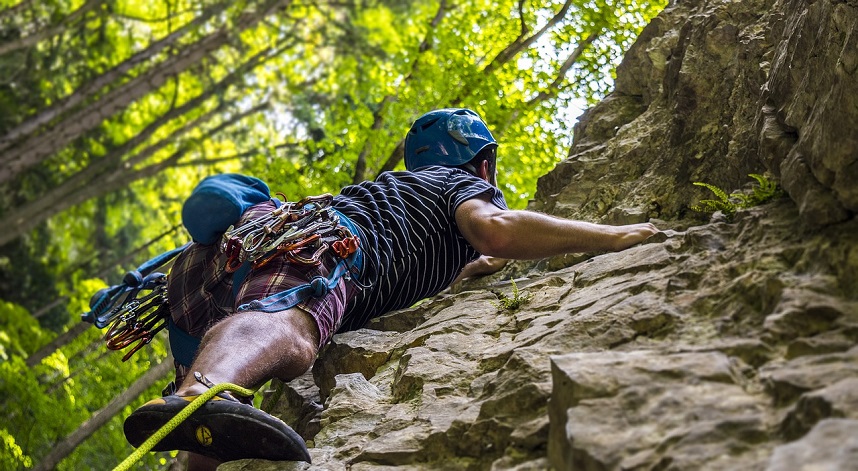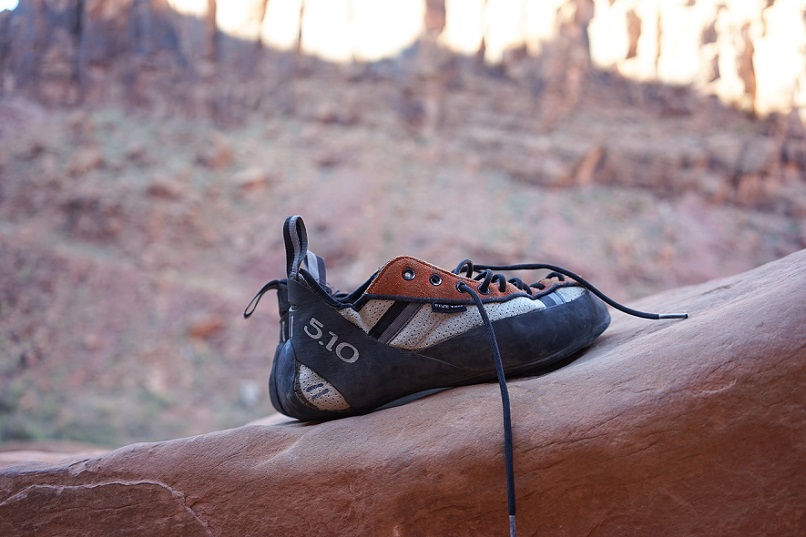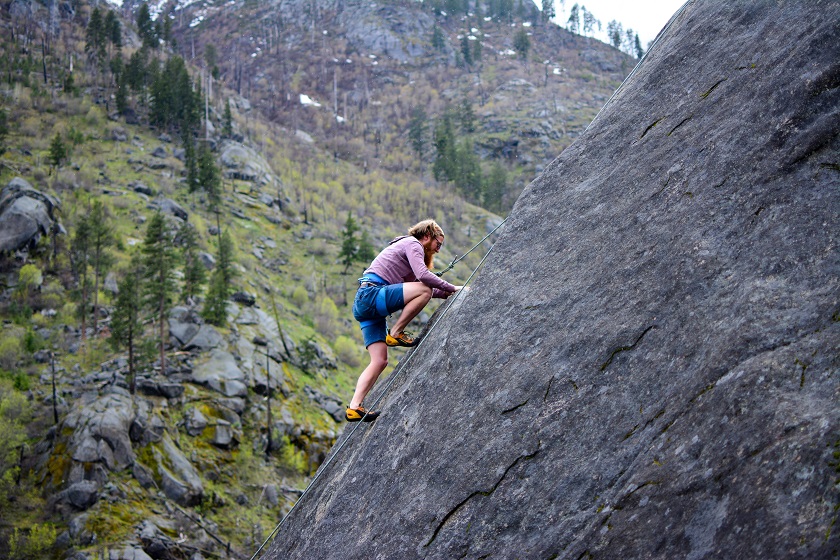All seasoned climbers remember the moment where they first thought about the shape of a climbing shoe.
Why on earth are climbing shoes toes curled? Do climbers take pleasure in the agonizing pain of small, unnaturally curled climbing shoes?
Nope, we don’t.
We may take pleasure in the pain of gain…
And we may even feel good about a painful flapper, just because it reminds us of the fact we got it from sending a nice overhanging problem!
But we’re (generally) not masochists and so we don’t wear shoes with curled toes just for the fun of it.
In reality, the curled shape of climbing shoes serves a very important purpose.
The curled shape of the climbing shoe can aid the climber in various climbing problems, but it is not ideal for every climbing situation.
In this article, we’ll dive into what the purpose is of ¨curled¨ or ¨downturned¨ or ¨camber¨ climbing shoes.
We’ll talk about how exactly it helps you in your climbing, for what sorts of climbing problems curled shoes are best, and whether it is advisable for beginners to buy shoes that are aggresively downturned at all.
Here’s how the curl of the shoe makes your foot stronger
Downtunred climbing shoes help you latch on to small edges that’d otherwise be impossible to stand on.
How?
Well, to explain how to camber helps to support your foot, we need to do a small experiment.
- Place you hand flat on the table
- Put force on your fingertips and press down on the table
- Note how much force you’re able to put out
- Now, curl your fingers, as if you’re holding a ball in the palm of your hand
- Put force on your fingertips again
- Be amazed by the difference between the flat and the curled position
As you can see, you’re able to put a lot more force on the tips of your fingers just by curving your hand.
Because of the curve, you’re entire hand is supporting the pressure on your fingertips.
Climbing shoes do exactly the same for your feet.
Because of the downturn, your foot is shaped in such way that the entirety of your foot supports your toes, focussing all force in a small point. This increases the load they can handle.
In a way, curled climbing shoes are nothing but a means of making your feet crimp, as you would do with your hands when holding onto an edge. This makes curcled climbing shoes an excellent choise for climbing problems that involve a lot of edging and hooking.
For what climbing problems do I need downturned shoes?
Not every climbing problem requires downturned shoes.
For example in crack climbing, professional crack climbers all say that they prefer soft, neutral shoes, because this type of shoe helps them better in jamming and locking their foot into the crack.
For dynamic problems where you’ll need to run up or past a part of the wall, moreover, downturned shoes can be a real hassle to deal with.
So contrary to popular belief, agressively downturned shoes are not the one and only sign of an experienced climber.
Still, you’ll notice that as you get better at climbing, you’ll start to prefer downturned shoes more and more for most of your climbs.
So for which climbs exactly do you need downturned or curved shoes?
Well, we’ve already mentioned hooking and edging.
Edging means placing your foot on a very narrow ridge or ledge, often no more than a couple of centimers wide. Curved climbing shoes excell in this scenario, because they enable your foot to concentrate all your body weight in a small point, small enough to fit on the edge. Because the shoe itself is already curved, it moreover provides your foot with the support to be able to hold on to this position, without collapsing.
When edging with softer shoes, you’ll find that your toes want to collapse upward, which moves your centre of gravity slightly away from the wall, which makes it more difficult to stay on to the edge.
Hooking can refer to toe hooking and heel hooking. The curvature of the shoe mainly helps your toe hooking.
Toe hooks are especially useful in climbing overhangs and roofs.
One of the uses of toe hooks is to shift your center of gravity. That means that you’ll often find yourself toe hooking an edge that’s pretty for away from your current centre of gravity.
Since you’ll have to stretch your leg to reach the edge with your foot, it’s rather difficult to curl your toes downwards as your leg is extended.
This is where the curvature of your shoe will help you. Because of its rigid downturn, the shoe provides your foot once again with the structure it needs to press down or press up against the wall as you shift your centre of gravity or move weight from your arms to your legs. This is also the reason why most downturned climbing shoes are covered all around the toes in a grip increasing material, such as rubber.
Should beginners get aggresively downturned climbing shoes?
My advice follows the general consensus: stay away from too aggresively downturned shoes if you’re a complete beginner.
Most of the problems you’ll climb won’t require an aggresive camber until you improve your technique anyway.
As you climb more and get better at climbing, you can slowly expand into downturned climbing shoes. By the time you’ll be needing a downturned shoe, your first pair of climbing shoes will be completely torn anyway.
So start with beginner shoes that are neutral to slightly curled. I’ve written a guide on the best climbing shoes for beginners here.
Once the holes start showing in those shoes, it’s time to go for a moderately downturned climbing shoe, like my favourite climbing shoe, the Scarpa Vapor V.
If you’re years in, you might consider this beast of an aggresive climbing shoe made by La Sportiva…. But for now, you should stay away from that.
And remember, more aggresive isn’t always better. There’s nothing wrong with climbing with neutral or moderate climbing shoes.
But not climbing because your aggressive shoes hurt you too much? That’s where the real problem lies!
Related questions
Here’s some other questions people often have that are related to our main question:
Should my toes be curled inside my climbing shoes?
Other than following the natural curvature of the shoe, your toes shoes not be curled up in your shoes. They should touch the outward edge of the shoe, however.
Are climbing shoes supposed to be tight?
Yes, climbing shoes should be tight but not too tight. It is important that you have no space between your foot and the shoe because it might come off otherwise and decrease your grip. If the tightness of your climbing shoes are holding you back from making a lot of climbing hours, however, the small gain of a tight shoe is easily dwarfed by the loss of practise hours.






